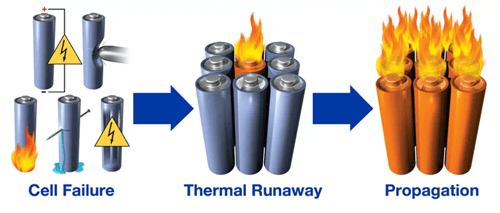What is Thermal Runaway?
What Is Thermal Runaway?
Thermal runaway is a catastrophic failure mode of lithium-ion (Li-Ion) batteries, where a rapid and uncontrollable increase in temperature occurs, leading to the release of stored energy almost instantaneously. This release manifests as intense heat, accompanied by the violent expulsion of flammable gases, such as hydrogen fluoride, and particulates, which can ignite, causing fires or even explosions.
The phenomenon is typically triggered by an internal short circuit, overcharging, deep discharging, or exposure to extreme temperatures. Once a single cell experiences thermal runaway, the heat generated can cause adjacent cells in the battery pack to enter thermal runaway as well, potentially spreading the failure throughout the entire battery module.
Impact on Equipment
Thermal runaway can severely damage the equipment powered by the Li-Ion battery. In consumer goods, such as smartphones or laptops, the failure of a battery can destroy the device, render it inoperable, or cause other internal components to overheat, potentially leading to a complete system failure. In larger systems, such as electric vehicles (EVs) or energy storage systems, thermal runaway can compromise the entire battery pack, often requiring costly replacements or repairs. This could lead to significant downtime for vehicles or machinery, loss of functionality, and high maintenance costs.
Impact on the User of Equipment
For the user, thermal runaway presents serious safety risks. The intense heat generated during the process can cause severe burns, while the release of flammable gases can lead to fires or explosions that endanger the person handling the device. In the case of EVs or other large-scale applications, the risk of injury or death increases significantly if the battery fails in an enclosed space, such as inside a car. In extreme cases, exposure to toxic gases released during the failure can lead to respiratory issues or long-term health problems.
Environmental Impact
Thermal runaway can also have harmful environmental consequences. The release of hazardous chemicals, including toxic gases and particulates, can contaminate the surrounding area, particularly if the device catches fire or explodes. These chemicals, such as lithium salts and heavy metals, are not only dangerous to human health but can also leach into the soil or water supply if not properly contained, contributing to environmental pollution. In cases of large-scale battery failures, such as those involving electric vehicles or energy storage systems, the resulting fires can lead to the destruction of valuable resources and habitats.
Ultimately, thermal runaway is a critical safety concern, and its prevention requires careful battery design, effective thermal management, and adherence to proper handling and charging procedures.
Causes of a thermal runaway event
- Internal Short Circuit | A malfunction within the cell, such as a punctured separator or a manufacturing defect, can create a short, causing localized heating that escalates into thermal runaway.
- Physical Damage | External impacts, such as crushing, puncturing, or dropping the battery, can lead to internal short circuits or compromised seals.
- Overheating | Exposure to external heat sources, or the battery operating in excessively hot environments, can increase the risk of thermal runaway.
- Overcharging | Charging beyond the battery's rated capacity can increase internal pressure and temperature, destabilizing the cell.
- Deep Discharge | Draining a battery too much can lead to chemical imbalances, increasing the risk of short circuits and other failures.

How to Mitigate Thermal Runaway
Unless additional safety solutions are employed to control heat transfer between battery pack elements, remove thermal energy from the system, and extinguish open flames resulting from a runaway event a compromised Li-Ion battery will cause adjacent cells or modules to enter thermal runaway as well, resulting in the fiery explosion of the entire battery pack in what is termed ‘thermal runaway propagation’.
Mitigating this risk is a key element of safe battery pack design and requires a nuanced solution to each of the various dangers associated with thermal runaway of Li-Ion batteries.
Latent Heat Solutions’ XTS product line is designed and tested to mitigate these critical threats to battery pack components, and completely prevent thermal runaway propagation in a single compact, cost-effective package.
Not Sure Where to sTart?
Our experts are specialized in working with you from start to finish.



